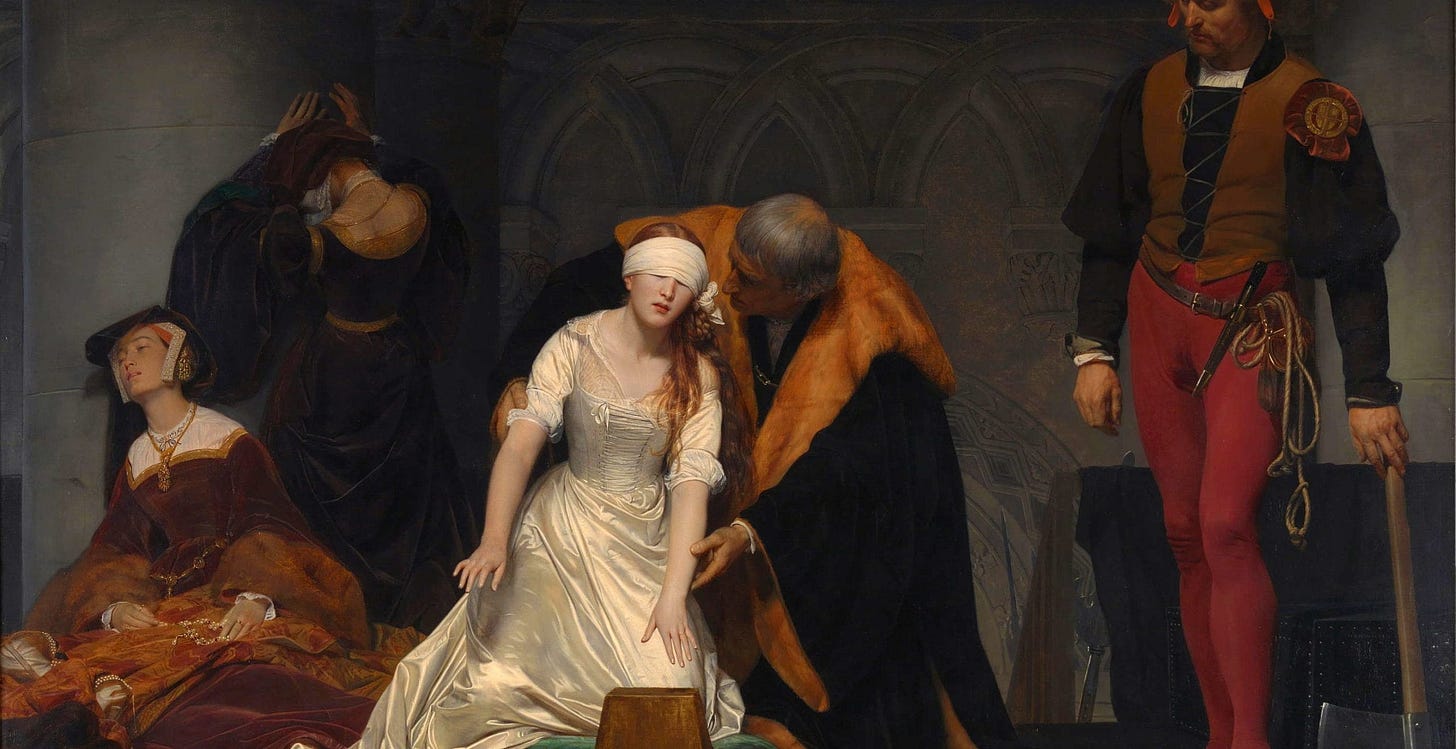The Actual Life and Death of Lady Jane Grey
Featured in Plan for the Worst by Jodi Taylor
In Hope for the Best, history has gone wrong and instead of reigning for only nine days, Lady Jane Grey – now known as Queen Jane the Bloody – actually reigns for 30 years. Here we examine her actual life and death as recorded in history.
Lady Jane was born into a high-status family, the daughter of Henry Grey, Duke of Suffolk and Frances Brandon, who was the daughter of Mary Tudor, King Henry VIII’s youngest sister.
In the spring of 1547, Jane went to live with Thomas Seymour and his wife, Katherine Parr, surviving widow of Henry VIII. Thomas’s sister was Jane Seymour, Henry’s third wife, who had died after the birth of Edward VI. Through the influence of Katherine Parr, Lady Jane received a Protestant education and became passionately devout.
The ambitious Thomas saw an opportunity in Jane and knew that having her under his influence could be politically advantageous and planned to marry Jane to Edward once they reached maturity. However, his ambition got the better of him when he attempted to break into Edward VI’s private apartments on the night of January 16, 1549. Alerted by a barking dog, Thomas was arrested and consequently executed four days later. Although blameless, Jane was sent home and her prospects of marrying the king were dashed.
Meanwhile, Thomas’s brother, Edward, had proclaimed himself Lord Protector of England. His attempts to rule on behalf of the child king were disastrous. By 1549, England was almost bankrupt, and members of the Privy Council removed him from power.
Led by John Dudley, who became Earl of Northumberland, Edward Seymour was overthrown, arrested, charged, and eventually executed at the Tower of London in 1552.
John Dudley proved to be more successful at running the country and the king, now a teenager, was growing in confidence and becoming more assertive. Strongly Protestant, his priorities were to hasten the pace of religious reform and consider the succession. This need for an heir became more vital when he fell ill with a fever and cough in January 1553. Historians think this might have been tuberculosis or some other respiratory disease, but from then on, his health remained fragile.
Concerned about an heir, the young king wrote his Devise for the Succession. Above all, Edward wanted to ensure his successor was a male Protestant. As a result, he disinherited his half-sisters Mary and Elizabeth in favour of the male heirs of his cousin, Lady Frances Grey or of her children, Jane, Catherine and Mary.
John Dudley, very mindful of the possibilities of Edward’s latest ‘devise’, married Jane to his son, Guildford Dudley. In the case of Edward’s death, Jane and Guildford would become king and queen. Lady Jane was married alongside her sister Catherine Grey and sister-in-law Catherine Dudley in a triple ceremony at Durham House.
However, by June 1553, it became clear that the king was fatally unwell, and since none of his cousins had yet produced a male heir, he changed his ‘devise’ in favour of the Lady Jane. In July Edward VI’s brief reign came to an end.
On 9th July, Jane was summoned to Syon House, her father-in-law’s London home, to be informed she was now to be crowned queen, as per Edward’s instructions. The news was said to come as a huge surprise to Lady Jane, who became very distressed. Some accounts claim she fainted after being informed of the life-changing news. It was not until her parents and husband arrived that she was calmed. The next day, Jane, her husband, parents, mother-in-law, and other court ladies entered the Tower of London, where new monarchs traditionally stayed from the time of their accession to their coronation.
Jane’s reign began to unravel almost immediately. The people of London, who were overwhelmingly sympathetic to Mary’s claim to the throne, greeted Jane’s accession with shock and hostility — so much so that the imperial ambassador reported that ‘no one present showed any sign of rejoicing’.
Mary, the only daughter of Henry VIII and Catherine of Aragon, wrote to the Privy Council stating her own claim. The Council members, the Archbishop of Canterbury and several other powerful men, all underestimated the strength of support for the Catholic princess, and in a joint reply, advised her to be “quiet and obedient”. Shortly afterwards, and realising they had “fatally misjudged Mary’s popularity”, they sent a small army to capture her at Framlingham Castle.
Mary, however, wasted no time in raising a larger army, leading John Dudley to retreat and before he had managed to return to London, the Council had shifted its support to Mary. She was proclaimed queen on 19th July 1553.
Jane, still at the Tower of London, was immediately abandoned. Her father rushed to proclaim Mary on Tower Hill, and her mother and ladies-in-waiting were quick to follow.
John Dudley was deposed later that month, while Jane and her husband Guildford remained at the Tower, but as prisoners rather than prospective queen and consort. They were tried for high treason in November 1553, charged, and sentenced to death.
Mary, now queen, was eager to begin her reign by demonstrating clemency and had intimated to those at court that she could not be induced to consent to Jane’s death. Not only was Jane her cousin, but Mary was also acutely conscious of Jane’s youth and the fact that she had been manipulated. It seemed that Jane’s life was safe.
However, that all changed in 1554. Mary’s plans to marry the hated Philip II of Spain made her deeply unpopular and fuelled a series of uprisings, including the plot known as Wyatt’s Rebellion.
There had been no intention to reinstall Jane as queen, but her father had been involved in the plot, ultimately putting Jane and her husband in a potentially fatal situation. Jane had known nothing of the rebellion but, now imprisoned in the Tower, she would have been painfully aware that her life depended on its outcome. Its failure sealed her fate.
By simply existing, Jane would always be a threat to Mary, who could not afford to let her cousin live. The queen offered to spare her life if she converted to Catholicism, but Jane refused. Mary reluctantly accepted the Privy Council’s advice and ordered Jane and Guildford’s executions.
On 12th February 1554, Guildford was taken to Tower Hill and beheaded. Jane watched from her window as his headless body was carried back to the chapel. When her turn came, she asked the executioner to “despatch her quickly.” A blindfold was tied around her eyes which led to her groping blindly for the block.
Panic overcame her and she cried: “What shall I do? Where is it?”
After someone stepped in to help, Jane laid her head on the block. As she spoke her last words: “Lord, into thy hands I commend my spirit”, the axe fell. She was just 17 years old.
Discover how Max and the team from St Mary’s fared in Hope for the Best by Jodi Taylor.
We hope you have enjoyed this History Briefing - please CLICK HERE to read more background history from The Chronicles of St Mary’s series by Jodi Taylor.
Have you discovered The Official Reading Companion and History Briefings for The Chronicles of St Mary’s series by Jodi Taylor?
If you've ever found yourself wondering who did what, when, and where in Jodi Taylor’s brilliant Chronicles of St Mary’s series — this is the companion guide you’ve been waiting for.
This guide is a must-have for both dedicated fans and curious newcomers. It contains synopses of every book and short story, detailed floor plans of St Mary’s Institute for Historical Research, History Briefings, chronological jump lists, character information, and more.
Whether you’re brushing up on the timeline or want to immerse yourself further in the chaos and charm of St Mary’s, this guide is your ultimate companion.
CLICK HERE to learn more.




